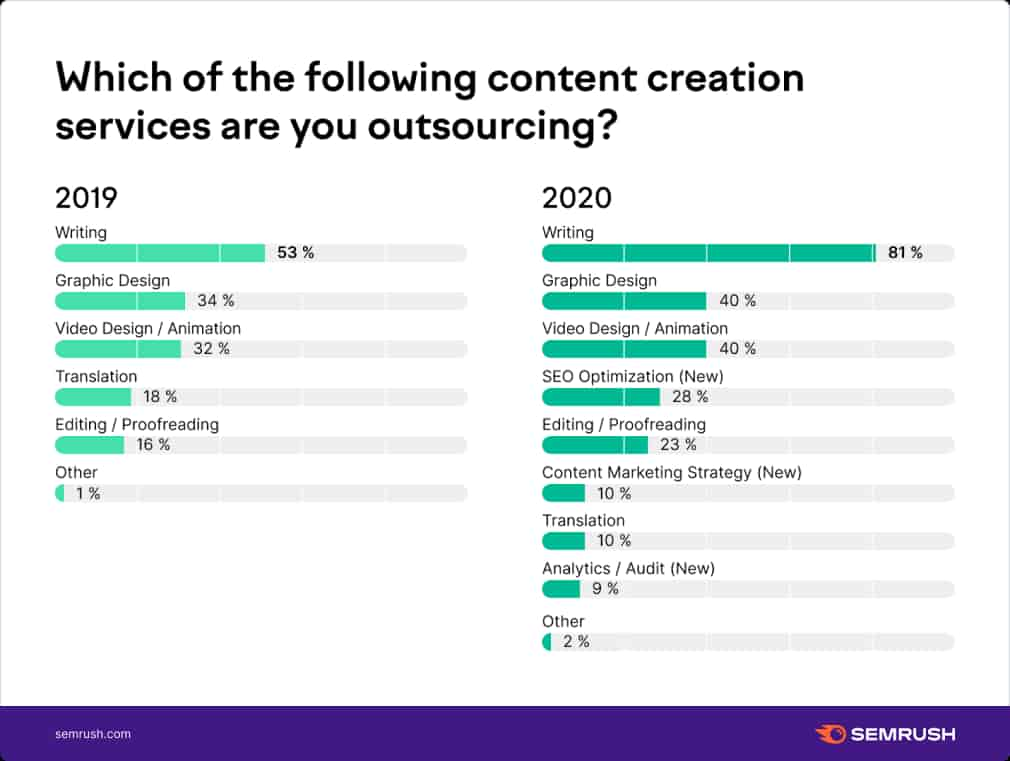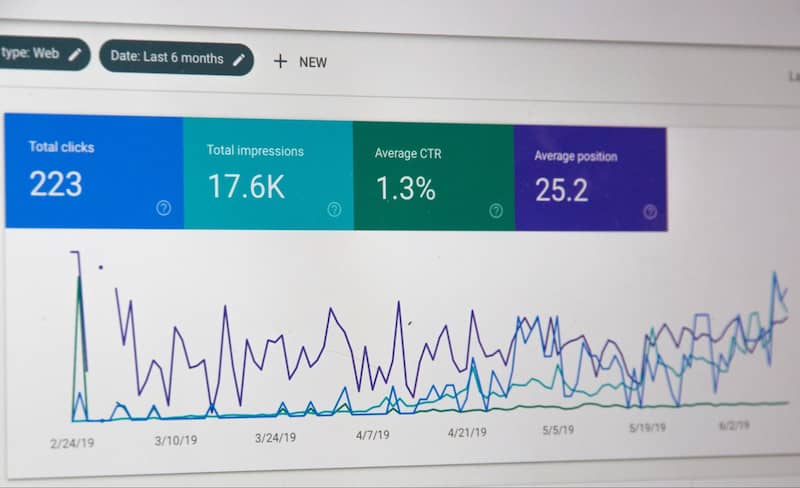Content Plagiarism: How It Affects Your SEO and Tactics to Avoid It
One of the quickest ways to sink your SEO efforts is to plagiarize content. While it may be tempting to copy and paste bits and pieces of articles you found on the internet, it is not worth it in the long run.
Understanding content marketing is more important than ever. Everybody is creating content, and the market has become oversaturated. This means that it is important to take steps to ensure you aren’t plagiarizing content, even if it’s accidental!
It is well-known that content improves SEO, so the scramble to create more efficient content can lead to cutting corners. Teams are outsourcing to create more content — 81% in 2020 compared to 53% in 2019.
Since most brands aren’t writing their own content, its essential to diligently check all content for plagiarism. And, of course, content plagiarism is something you should be concerned about whether you’re doing all your content marketing in-house or outsourcing to freelancers.
Content plagiarism is unethical and illegal. It’s not a victimless crime but an offense that can seriously hurt businesses that run plagiarized content. Search engines like Google have complex and powerful systems to penalize this behavior, which defeats the purpose of churning out more and more content.

Sections
- A brief history of plagiarism
- What is content plagiarism?
- How does content plagiarism affect your SEO?
- What’s the difference between content plagiarism and duplicate content?
- How can you avoid content plagiarism?
A brief history of plagiarism
The first documented plagiarism case was by the Roman poet Martial, who in the 1st century, used the Latin word “plagiarus” to describe people reciting his poems as their own. “Plagiarus” had previously been synonymous with the word “kidnap.” He wrote this poem addressed to Fidentinus, whom he believed plagiarized his work:
Fame has it that you, Fidentinus, recite my books to the crowd as if none other than your own.
If you’re willing that they be called mine, I’ll send you the poems for free.
If you want them to be called yours, buy this one, so that they won’t be mine.
Since this first documented case of plagiarism, it has been widespread in academia, journalism, marketing, and pretty much any written content. Here are a few statistics on the current state of plagiarism, copyright infringement, and duplicate content.
- Wikipedia is the most plagiarized website, followed by Yahoo! Answers and Answers.com
- Google has 7,075,952,499 URLs requested to be delisted for alleged copyright infringement
- 29% of websites have duplicate content
What is content plagiarism?
Plagiarism is the unethical and illegal act of passing off somebody else’s creative work as your own. However, when we talk about content plagiarism we’re specifically talking about copying SEO web content like blog posts and articles.
While most ethical marketers avoid blatent plagiarism, there are many ways it can creep into content. It’s so widespread that chances are you have plagiarized content on your website right now.
SEO growth content is, in part, a numbers game; you need to produce a lot of content to grow your backlinks and domain authority over a long-term campaign. It is tempting to scale up production by plagiarizing without doing the work required.
- Some marketers will choose to outsource the work, but that opens up the risk of hiring content plagiarists looking to churn out decent-looking work and get paid before their clients realize what’s happened.
- If you create content in-house, it may be tempting to copy chunks of existing content and insert it into your own work. This is the most common form of plagiarism and can hurt your SEO.
There are three main kinds of content plagiarism you need to be aware of. Let’s take a look.
Copy-pasting
At the bottom of the barrel, you’ll find plagiarists who just copy and paste chunks of other people’s writing into their own article. They’ll polish up the H1 and H2 headings to meet your SEO goals, then publish it with no attention to the writing that goes in between them.
These articles often don’t even make sense, as there’s no attention to the structure of the logical flow of arguments. Even worse, if at any point a writer on a deadline has published a factual error, that error will be copy-pasted across their WiFi network but reproduced all over the internet.
This type of plagiarism can quickly lead to misinformation, especially if the content plagiarist is copy-pasting from low-quality articles that have themselves been copy-pasted. Whole search-results pages could be filled with this misinformation without anyone intending to mislead the searcher.
Patchwriting
“Patchwriting” was a word coined in the early 1990s by writing professor Rebecca Moore Howard, when students were just starting to write their essays on desktop computers. As soon as students had access to the copy-paste feature, they were using it to fill up their essays’ word counts the night before their work was due.
But unlike the copy-paste plagiarists, these early patch writers had the good sense to change a few words around so that their plagiarism went undetected.
Sometimes these students weren’t looking to deceive. They were just writing about a topic they didn’t understand well enough to re-describe in their own words. Being able to describe a topic to someone else is one key marker of understanding – the “Feynman Technique” for accelerated learning is built on this – and these students were compensating for their lack of understanding by paraphrasing the writing in their textbooks or online sources.
The modern-day patch writer is not so innocent. Much like the copy-pasters, these are content writers trying to turn around cheap work faster with little effort.
They’ll take a line like “football is one of the most popular sports in the world” and change that to “one of the most popular sports in the world is football.” They’ll stuff some of the necessary keywords in there and send it away to the client. This is a big SEO mistake. If the client doesn’t notice the plagiarism, Google will.
Unintentional plagiarism
Not all plagiarism is intentional. If you and your competitors are writing about a very narrow, very technical subject like PBX hosting, it can be hard to find many fresh angles on that particular topic.
Although, there’s no room for interpretation. The facts are either accurately described, with the correct technical terminology and relevant industry jargon, or they aren’t. You might end up repeating points your competitors’ blog posts made simply because there’s only one correct way to describe your product in detail.
If you’re not careful about your word choice, you could inadvertently plagiarize a short section of a competitor’s writing. If your blog post ranks well on a keyword, your competitor might notice your post and not unfairly accuse you of stealing their work. That’s just one of the serious risks that content plagiarism poses to your company, as we’ll see below.
How does content plagiarism affect your SEO?
Your SEO content strategy will include a plan for creating high-quality, engaging content on a weekly/monthly basis, a strategy for building up authoritative backlinks, and the market knowledge to optimize your content with relevant keywords.
Understanding your audience’s search habits is one of many essential virtual sales techniques your team should be mastering. Original copy allows you to:
- Lead high-intent customers down your marketing funnel (“money content”)
- Get your message in front of potential customers who are just looking for information (“supporting content”).
Good content is key to building your brand and establishing your company as a trustworthy and authoritative player in your industry. That brand recognition will help you quickly establish strong relationships with potential and loyal customers, which you can leverage to get unique benefits like zero-party data.
“Zero-party” data is better than third-party data and even better than the first-party data you’re collecting from analytics. It’s information given to you directly by your customers, such as:
- Their name
- Preferences
- Personal information
This is some of the most valuable data you can get from customers, and you’ll only get it by meticulously building a strong, trustworthy brand.
The strength of your brand is directly reflected by your bottom line. It’s how Apple can charge upwards of $1000 for an iPhone that costs them $570 to build. It’s how Tiffany & Co. can charge a much higher price for similar jewelry to their competitors.
Even a small increase in your AOV average order value, multiplied by the number of customers, can make a huge difference to your yearly revenue.
It’s common for users to open multiple search results if they’re looking for product information. If they see that your content is very similar to another page’s content, then you risk losing all trust in your brand from that person.
It doesn’t matter if that other page is the one that plagiarized you; how is anyone to know? It’s just as important to make sure your own content isn’t being plagiarized.
Content plagiarism won’t just tarnish your brand. It will also seriously harm the SEO rankings you’ve worked hard to build up over time.
Here are some common ways plagiarism can hurt your SEO:
- Google prefers older, more established content. By now, Google’s web crawlers know plagiarism when they encounter it. If it suspects content may be plagiarized, it will rank it lower in search results.
- Web scrapers steal whole articles and publish them to a spam site to try and build up strong backlinks from authoritative sources. Have you ever come across one of those pages in search results? No? That’s because Google simply ignores plagiarized content.
- If a writer copy-pastes chunks of another writer’s article on your behalf, your age will simpy not rank for the target keyword. You’ll have wasted your precious marketing budget while the plagiarist goes on to rip off another client.
And that’s only where your troubles begin. If Google detects plagiarized content on your page, it could start to affect SEO rankings across your entire domain. This will directly affect your company’s sales numbers.
No company can scale if its sales team is spending all its time chasing potential customers. Good SEO is vital for allowing customers to come to you first. With competition for sought-after keywords so high, SEO is a winner-takes-all game. Even a slight across-the-board reduction in your domain’s rankings could cause serious harm to your company’s bottom line.
After repeated offenses, Google might just drop your domain from search results entirely. Plagiarism might get your blog posts out of the door a little faster, but the potential damage is serious.
What’s the difference between content plagiarism and duplicate content?
It’s important to know the difference between plagiarized content and duplicate content. Understanding this nuance would save a lot of anxiety and dispel one of many SEO myths.
Duplicate content is any content that you’ve legitimately copied between pages. This could be the same product description repeated across different pages or domains, or the same blog post syndicated across sites.
Google’s duplicate content guidelines are clear about what they’ll penalize and what they won’t.
Google says:
“Mostly, [duplicate content] is not deceptive in origin. However, in some cases, content is deliberately duplicated across domains in an attempt to manipulate search engine rankings or win more traffic. Deceptive practices like this can result in a poor user experience when a visitor sees substantially the same content repeated within a set of search results.”
The guidelines offer a list of ways to avoid your duplicate content causing SEO issues in the way that plagiarized content would.
The main one you need to know about is the “rel=canonical” tag. This is an HTML tag containing a link to your original content’s URL, telling Google that the version of the text on your site is the original.
Syndicating the same content across multiple sites is a totally above-board marketing and SEO strategy. In this instance, Google’s advanced crawlers aren’t likely to flag your duplicate content as plagiarism.
You can syndicate your post about call center analytics to a hundred sites with no worries. Google will only display your own site’s “canonical” page as the top result for that specific keyword.
How can you avoid content plagiarism?
One big part of SEO content writing is keyword mapping and competitor analysis. Here, of course, you’re going to be writing about similar topics to your competitors.
Depending on your product, you might need to use longer keywords like “specialty coffee in New York” or “phone system for small businesses” to get in front of your target audience. Is taking a long keyword from your competitors plagiarism? No, that’s just the SEO game.
If you’re performing your own content writing, it’s easy to avoid writing something too similar to other articles. If you’re writing a piece of content for a specific keyword, you’re likely selling your product vs. your competitors, so you should have plenty to say that’s different from anyone else.
If you’re writing a piece of supporting content, something along the lines of “how to optimize a model risk management software” or “how to avoid client over-servicing”, you might read similar articles online to get a feel for what people are interested in in addition to whichever product or service you’re promoting.
In this case, take any summary notes in your own words, strictly no copy-pasting, and add your own insights there and then. Don’t consult the articles again.
You should have a well-defined brand voice, even in a B2B setting. As you write, you should not only be leveraging your own writing style in the notes but your unique brand voice. If you and your competitor are selling the same widget, your brand story surrounding the widget is the point of differentiation.
That’s becoming more true in more industries every year. As companies increasingly run their operations on the same platforms and APIs, how well they know their customers becomes the main thing they’re competing on.
Think about how to make the content more relevant to your target audience and their needs. If you understand them better than the other team, you’ll have plenty of unique insights. Even better, sprinkle in your own first-party data where appropriate; it’s a sure-fire way to create something no other company can.
If you’re struggling to find a new angle on a keyword topic, one tried-and-true method is to just write exactly the opposite. If your competitor has a nice article about how their BCM software can help customers prepare their companies for severe disruption, you could write an article about everything that could go wrong if companies aren’t using your BCM software.
In this case, activating the fear of disruption in the searcher is bound to get them to click on your article title in the search results. Just by finding a new angle on the subject matter, you’ve understood the customer’s anxiety around severe disruption and reflected it. You’ve met their needs better than the competing piece of content.
As scaling content output becomes essential, more marketing teams are outsourcing their content to third parties. Content plagiarism becomes much more of a problem here, but there are a few reliable ways to make sure nobody tries to rip you off by selling you plagiarized content.
Before you pay for a piece of outsourced content, run it through a plagiarism checker. There are plenty of these to choose from, such as:
- Copyscape
- WordStream
- Copysentry
- Unplag
Grammarly’s plagiarism checker will also check for plagiarism as well as perform a detailed check on the piece’s spelling and grammar. It’s a good idea to use this if you’re writing your own content too. This will help you avoid an embarrassing typo as well as any content that looks too similar to someone else’s.
If you’re looking to outsource your content writing, be very diligent about where you advertise this position and where you hire freelancers. Look into reputable platforms like Contentfly and Scripted, which specialize in content and copy, rather than putting the feelers out to everyone on Fiverr or Upwork.
As with cybercrime and mobile ad fraud, certain bad-faith activities like content plagiarism are thriving in a world of increasingly remote work. Professional relationships are becoming more abstract and more exposed to complex networks. This reduced visibility makes it easier for bad actors to slip in thinking they’ll go unnoticed.
With mobile ad fraud, part of the solution is the breaking down of communication silos both within and between companies. Utilizing asynchronous communication for remote teams is one easy method for doing this. If you’re working with partners to publish or produce SEO content, closer communication with everyone involved reduces the chances of plagiarized content slipping through the cracks.
Avoiding the risks of plagiarism
Content plagiarism can seriously affect your SEO effort if you’re not careful.
Thankfully, all that’s required from you to avoid it is some diligence on the pieces you’re writing and publishing on your domain.
About the author
Brianne Schaer is a Writer and Editor for Reputation X, an award-winning online reputation management services agency based in California. Brianne has more than seven years of experience creating powerful stories, how-to documentation, SEO articles, and Wikipedia content for brands and individuals. When she’s not battling AI content bots, she is cruising around town in her Karmann Ghia. You can see more of her articles here and here.
–

